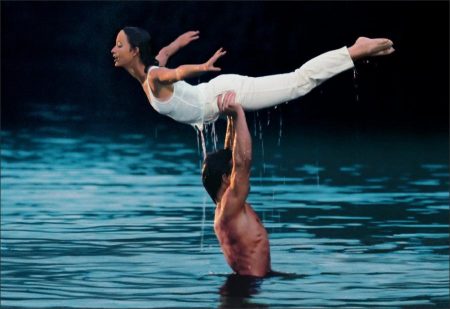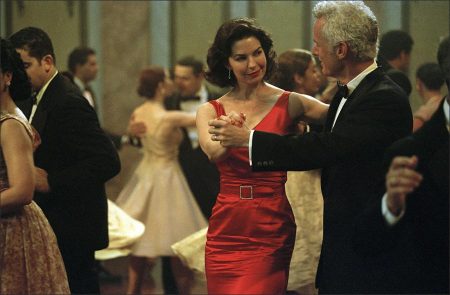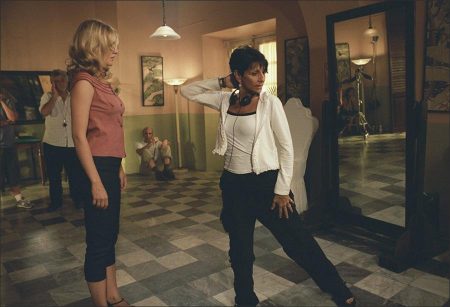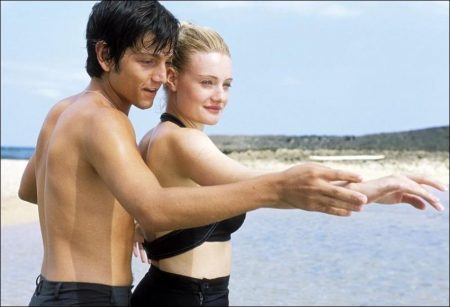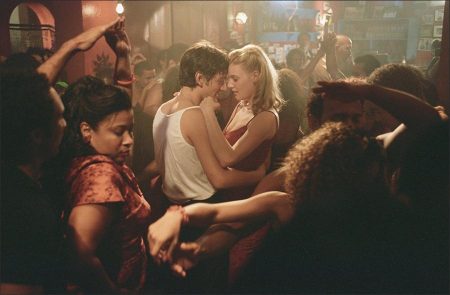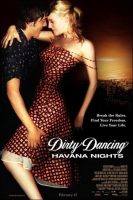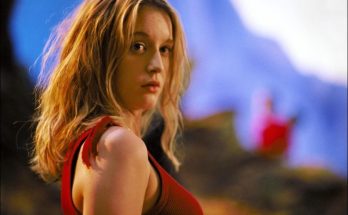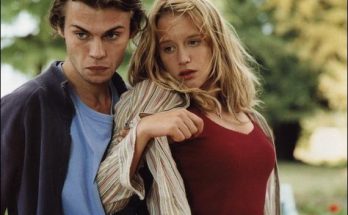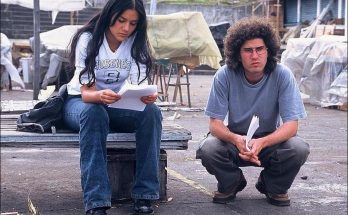>
Background and Story
Like the original Dirty Dancing, Dirty Dancing: Havana Nights combines romance, dance and personal history. In 1958, JoAnn Jansen was a teenager living in St. Louis, Missouri, when her father, an executive with Reynolds Aluminum, was transferred to Havana. Jansen didn’t want to leave her life in St. Louis, but of course had no choice. Her family joined the other American families in residence at Havana’s luxurious hotels, where every need was catered to and people socialized at posh country clubs, glittering private parties, and opulent nightclub/casinos. It was a culture shock, to put it mildly.
“We were a middle-class family,” Jansen recalls. “Suddenly, we were living in a fancy hotel, with maids and a chauffeur available at all times. We were expected to be part of the high-class North American group, but I fell in love with a Latin boy who introduced me to an amazing country.”
In discovering Cuba, she discovered a culture where dance and music were part of everyday life. Jansen knew dance well; she had studied ballet for years and her parents had been professional ballroom dancers. But the dancing in Cuba ‘ how people moved, the ways bodies touched – was a vastly different entity. Dance also gave ordinary Cubans a rare opportunity to speak their minds, using their bodies.
“I had never in my life seen anything that looked remotely like the dancing I saw in Havana,” Jansen remarks. “When people danced, it wasn’t connected to sex necessarily; it was about the freedom of your body and what it feels like to express yourself. I discovered that you could move your body any way you want; it’s part of your personality and nobody can take that from you. The Cuban people understood that deeply.”
Jansen’s experience in Cuba influenced her life in countless respects, including her choice of dance as a career. She was running her own modern dance company in New York when she first met Lawrence Bender, who began his career as a dancer and actor. They became friends and went on to work together after Bender became a producer, collaborating on motion pictures including Quentin Tarantino’s Pulp Fiction and Boaz Yakin’s Fresh.
Over the years, Bender and Jansen had worked on developing a film version of Jansen’s teenage experience. When Bender became involved with the production of a new chapter of Dirty Dancing, the pieces fell into place. “I was talking to JoAnn and Boaz Yakin and we realized JoAnn’s story would be great for a Dirty Dancing movie,” remembers Bender. “I’m an ex-dancer, so the idea of doing a dance movie or a musical is really close to my heart. It’s something I’ve wanted to do for a long time.”
With Yakin committed to doing an initial screenplay, in 2001 Bender and Jansen took their idea to Artisan Entertainment and Miramax Films, who had joined forces to produce the new Dirty Dancing. Bender explains that no one saw the new film as supplanting the first film. “I loved Dirty Dancing. There’s something really special about it,” he says, noting that upon its release the 1987 film became “a phenomenon. People had never seen dance like that before. But what really is interesting about this story is Cuba ‘ in a sense, Cuba is sort of the forbidden fruit. Most people in this country haven’t been to Cuba, and it’s a place that people have a fascination about.”
The story’s unique characters and setting were key in attracting award-winning director Guy Ferland, who has distinguished himself with such character-driven projects as the television series “The Shield” and the Peabody Award-winning telefilm Bang, Bang, You’re Dead. “What was interesting to me was that we had two characters who are basically polar opposites, and they find a common emotional ground. In today’s world, that is a great thing to tell a story about,” Ferland says. “The backdrop of Cuba 1958 is primarily a musical and cultural one. We get to explore these elements through the eyes of a naïve American girl. So the film is not only a romance – it’s a romance and a musical and a drama and a movie about culture and a foreign country.”
Film Review for Dirty Dancing: Havana Nights
Long in the works and the result of various attempted incarnations in the 17 years since Patrick Swayze and Jennifer Grey locked hips in the 1987 romance that became the guilty pleasure of a generation, “Dirty Dancing: Havana Nights” is less a sequel than a revisitation in a new setting of the same themes of young love, self-discovery and sexualized dance. Swapping early 1960s Catskills for late ’50s Cuba — against the backdrop of Castro’s revolution no less — the superficial but entertaining new pic offers equal parts freshness and kitsch appeal set to a pulsating Latin soundtrack that should prove commercially vibrant.
While teenage girls would seem the prime target for the Artisan-Miramax co-prod — going out Stateside through Lions Gate and offshore through Miramax — the original pic’s legions of passionate fans also likely will be curious to see how the formula has held up over time.
Despite being stereotypical teen fluff, “Dirty Dancing” remains one of the key pop culture phenomena of the late ’80s, spawning the immortal line, “Nobody puts Baby in a corner.” Directed by the late Emile Ardolino, it grossed $163 million worldwide and remains the top-selling title in the vast Artisan library now controlled by Lions Gate. The push to mount a sequel went through a number of turns, almost coming together at one point in a South Beach, Miami setting, pairing Natalie Portman and Ricky Martin.
Screenwriters Boaz Yakin and Victoria Arch, working from a story by Kate Gunzinger and Peter Sagal, have conserved the basic elements of “Dirty Dancing”: Bookish girl with burgeoning social conscience meets snake-hipped dancer; divided by class barriers and parental disapproval, they find love and rhythm through secret dance trysts. An opening credit pompously announces the story is “based on true events” — although press notes are unclear as to whether this refers to the youth of choreographer/co-producer JoAnn Jansen as an American teen in Cuba or the overthrow of Batista.
The girl this time around is Radcliffe-bound high school senior Katey (Romola Garai), who was uprooted by her parents and taken to Havana in 1958 during the period leading up to the revolution. Her father (John Slattery) has an executive position with Ford. Katey immediately bristles at the superior attitudes of the smart-set teens toward the Cuban wait staff at their swanky hotel, but agrees to date James (Jonathan Jackson), whose father is her dad’s boss. When they skip out on the square country club and head to steamy local hangout La Rosa Negra, James comes on too strong, causing Katey to dump him and hook up with hotel staffer Javier (Diego Luna), whose moves she admired earlier.
Unlike Grey’s character in “Dirty Dancing,” Katey has her own moves down thanks to her parents, who were Latin ballroom dancers in their youth. Her mother (Sela Ward) still regrets having given up her one-time passion.
Javier sparks Katey’s fire on the dance floor, but as a result of her sister Susie (Mika Boorem) seeing them canoodling later, he loses his job at the hotel. Katey convinces Javier to be her partner for a New Year’s Eve dance contest, saying he could use the prize money to help his family.
Using their guilt as leverage, Katey has Susie and James cover for her while she meets Javier for hot practice sessions. When her parents learn of the deception, they insist she end the inappropriate relationship, as does Javier’s revolutionary brother (Rene Lavan), who looks down on the privileged gringa. But nobody puts Katey in a corner either. As dance fuels romance, she becomes more rebellious and discovers the real Cuba, simmering with revolutionary upheaval.
The scripters and director Guy Ferland capably chronicle the obstacle-strewn romance and the mutual growth it affords both partners, and give more weight to the political backdrop than is necessarily expected in a teen romance. However, they fail to construct the same kind of syrupy closing-act emotional uplift that made “Dirty Dancing” end on a high.
Nevertheless, while it’s unlikely to make the same mark its predecessor did, the tightly edited new film is pleasurable froth that skips along to an infectious, syncopated rhythm, with handsome period production design, colorful costumes and Puerto Rican locations effectively standing in for Cuba. Lenser Anthony Richmond gives a rich, glossy look to the grand architecture of opulent hotels, plazas and cobbled streets bathed in golden light, and also covers the dance sequences — a mix of traditional Latin moves and wilder Afro-Cuban styles — with vitality and dexterity.
Chemistry between Garai and Luna is good considering the basic imbalance that it’s physiologically impossible to put a wholesome blonde next to a hot, wiry Latino and not have her look a little vanilla by comparison. British thesp Garai (“Nicholas Nickleby”) struggles mildly with the American accent but is fresh-faced, sweet and a graceful mover, at times resembling a younger Cameron Diaz. But it’s very much Luna’s show. The “Y Tu Mama Tambien” star sizzles on the dance floor and off it conveys relaxed charisma, boyish charm and sensitivity.
Ward and Slattery both have warm moments as Katey’s concerned but ultimately understanding parents. Establishing a link with the first film, a somewhat embalmed-looking Swayze shows up as a hotel dance instructor. Singers Mya and Heather Headley also appear as stage chanteuses, contributing to a terrific soundtrack that, like “Dirty Dancing,” juggles period tunes with contemporary sounds, creating a Cuban-hip hop bridge that should sell CDs. In a further nod to the 1987 film, instrumental versions of signature tune “I’ve Had the Time of My Life” grace some of the more tender moments.
Dirty Dancing: Havana Nights (2004)
Directed by: Guy Ferland
Starring: Diego Luna, Romola Garai, Sela Ward, John Slattery, Jonathan Jackson, January Jones, Mika Boorem, René Lavan, Mya, Polly Cole, Chris Engen, Tommy Kavelin
Screenplay by: Victoria Arch, Boaz Yakin
Production Design by: Hugo Luczyc-Wyhowski
Cinematography by: Anthony B. Richmond
Film Editing by: Luis Colina, Scott Richter
Costume Design by: Isis Mussenden
Set Decoration by: Alan Hicks
Art Direction by: Teresa Carriker-Thayer
Music by: Heitor Pereira
MPAA Rating: PG-13 for sensuality.
Distributed by: Lionsgate Films
Release Date: February 27, 2004
Visits: 193
